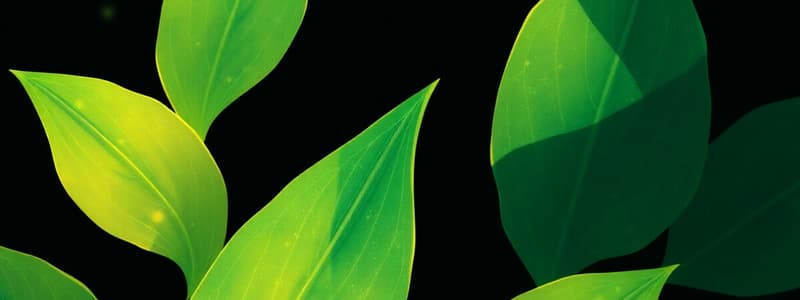Podcast
Questions and Answers
What type of venation is characterized by multiple main veins running parallel to each other from the base to the tip of the leaf?
What type of venation is characterized by multiple main veins running parallel to each other from the base to the tip of the leaf?
- Parallel costal venation
- Reticulate venation
- Parallel basal venation (correct)
- Palmate venation
Which function is primarily associated with the transport of sugars in the leaf veins?
Which function is primarily associated with the transport of sugars in the leaf veins?
- Transpiration reduction
- Nutrient transport
- Structural support (correct)
- Gas exchange
What type of leaf modification helps in climbing and has tendrils?
What type of leaf modification helps in climbing and has tendrils?
- Protective modifications
- Reproductive modifications
- Climbing modifications (correct)
- Storage modifications
Which of the following is an example of a plant with spiny leaves that serve protective modifications?
Which of the following is an example of a plant with spiny leaves that serve protective modifications?
What type of leaf modification is responsible for storing food or water?
What type of leaf modification is responsible for storing food or water?
Which of the following leaves is specialized for sexual reproduction?
Which of the following leaves is specialized for sexual reproduction?
In what way do sac leaves contribute to plant reproduction?
In what way do sac leaves contribute to plant reproduction?
What type of leaf has a blade that is undivided?
What type of leaf has a blade that is undivided?
Which example is associated with pinnately lobed leaves?
Which example is associated with pinnately lobed leaves?
What distinguishes palmately compound leaves from other types?
What distinguishes palmately compound leaves from other types?
What is the primary characteristic of reticulate venation?
What is the primary characteristic of reticulate venation?
Which type of venation is typical for monocotyledonous plants?
Which type of venation is typical for monocotyledonous plants?
What feature defines odd or imparipinnate compound leaves?
What feature defines odd or imparipinnate compound leaves?
Which type of leaf is further divided into pinnules?
Which type of leaf is further divided into pinnules?
Which of the following best describes palmate lobed leaves?
Which of the following best describes palmate lobed leaves?
Flashcards
Entire Leaf
Entire Leaf
A leaf blade that is undivided, meaning it has no lobes or divisions.
Lobed Leaf
Lobed Leaf
A leaf blade is divided into portions connected by tissue, producing a lobed appearance.
Pinnately Lobed Leaf
Pinnately Lobed Leaf
Leaf divisions extending from the midrib, creating a feather-like pattern
Palmately Lobed Leaf
Palmately Lobed Leaf
Signup and view all the flashcards
Reticulate Venation
Reticulate Venation
Signup and view all the flashcards
Pinnate Venation
Pinnate Venation
Signup and view all the flashcards
Palmate Venation
Palmate Venation
Signup and view all the flashcards
Parallel Venation
Parallel Venation
Signup and view all the flashcards
Parallel Costal Venation
Parallel Costal Venation
Signup and view all the flashcards
Leaf Venation Role
Leaf Venation Role
Signup and view all the flashcards
Spiny Leaf Modification
Spiny Leaf Modification
Signup and view all the flashcards
Tendril Leaf Modification
Tendril Leaf Modification
Signup and view all the flashcards
Storage Leaf Modification
Storage Leaf Modification
Signup and view all the flashcards
Flowering Leaf Modification
Flowering Leaf Modification
Signup and view all the flashcards
Study Notes
Leaf Shapes
- Simple Leaves (Entire or Unlobed): The leaf blade is undivided. Examples include corn, wheat, Duranta, and Ficus plants.
- Lobed Leaves: The blade is divided into sections connected by tissue.
- Pinnately Lobed: Divisions extend from the midrib. Examples include oak and papaya plants.
- Palmately Lobed: Divisions radiate from a single point. Examples include grape, fig, castor bean, Luffa, and hibiscus plants.
Compound Leaves
- Palmately Compound Leaves: Leaflets radiate from a central point at the end of the petiole. Leaflets are directly attached to the petiole. Examples include Aralia and Lupinus plants.
- Pinnately Compound Leaves: Leaflets arise along the main axis.
- Odd or Imparipinnate: The main axis ends with a single leaflet. Example: Rosa plant.
- Even Pinnate or Paripinnate: The main axis ends with a pair of leaflets. Example: Cassia acutifolia.
- Bipinnately Compound: Leaflets are further divided into pinnules. Pinnules are carried on second-class axles. Example: Poinciana plant.
- Tripinnately Compound: Leaflets are divided multiple times. Pinnules are carried on third-class axles. Example: Certain ferns.
- Trifoliate Compound: The compound leaf has only three leaflets. Example: Trifolium (Clover).
Venation
-
Venation: The arrangement of veins in a leaf blade; responsible for water/nutrient transport and sugar transport.
- Reticulate Venation: Veins form a network of interconnected branches.
- Reticulate Pinnate: A prominent midrib with smaller side veins branching off. Example: Ficus and rose leaves.
- Reticulate Palmate: Several main veins radiate from a central point. Examples: Grape and castor leaves.
- Parallel Venation: Veins run parallel to each other along the leaf's length. Common in monocots and some dicots.
- Parallel Basal: Multiple main veins run parallel from the base to the tip of the leaf, often parallel to the midrib. Example: Wheat, corn, and barley leaves.
- Parallel Costal: A single midrib with smaller veins that branch off at right angles parallel to each other. Example: Banana leaves.
- Reticulate Venation: Veins form a network of interconnected branches.
Leaf Modifications
- Protective: Reduced transpiration and protection against herbivores.
- Spiny Leaves: Reduce water loss and deter herbivores. Examples include asparagus, prickly pear, cactus, and some citrus plants.
- Climbing: Enhance climbing structures.
- Tendril Leaves: Aid in attaching to structures for climbing. Examples include pea, bean, and other plants.
- Storage: Storing water or food.
- Storage Leaves: Store water or food. Examples include succulent plants and bulbs.
- Reproductive: Specialized for sexual reproduction.
- Flowering Leaves: Specialized for sexual reproduction; bear reproductive structures like stamens and pistils.
- Vegetative Reproductive Leaves: Produce adventitious buds for asexual reproduction. Example: Kalanchoe pinnata.
- Secretory: Secrete nectar to attract pollinators. Example: Delphinium plant.
- Insectivorous: Trap and digest insects to obtain nitrogen. Examples include Drosera, Dionaea, and pitcher plants.
Studying That Suits You
Use AI to generate personalized quizzes and flashcards to suit your learning preferences.





